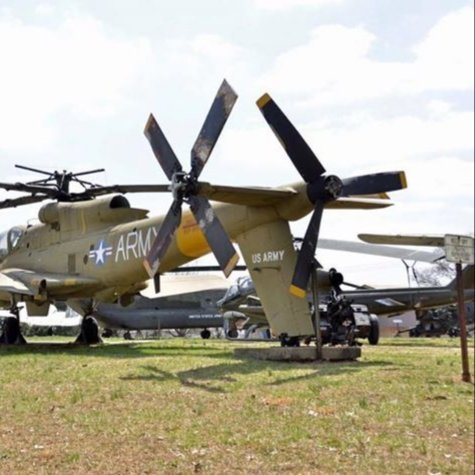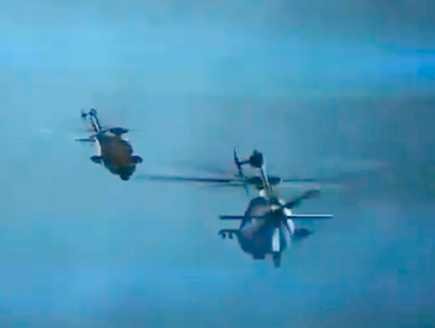You are using an out of date browser. It may not display this or other websites correctly.
You should upgrade or use an alternative browser.
You should upgrade or use an alternative browser.
JMR (Joint Multi-Role) & FVL (Future Vertical Lift) Programs
- Thread starter Grey Havoc
- Start date
- Joined
- 24 November 2008
- Messages
- 1,547
- Reaction score
- 2,597
Boeing statement: "...using proven technology and manufacturing techniques, creating a more affordable and low risk option..."Reliability I guessI'm surprised they're still using swashplates instead of computer controlled actuators.
- Joined
- 24 November 2008
- Messages
- 1,547
- Reaction score
- 2,597
We will find out soon.
"...With its strategy, Boeing appears to be repeating the approach adopted so effectively in earlier contests to supply the US Navy with an unmanned tanker and the US Air Force with a replacement fleet of advanced jet trainers. In both those instances, it surprised its adversaries by unveiling not a full-scale mock-up but what was essentially a flight-ready prototype..."
https://www.flightglobal.com/flight...ch-could-yield-armed-scout-win/136869.article
"...With its strategy, Boeing appears to be repeating the approach adopted so effectively in earlier contests to supply the US Navy with an unmanned tanker and the US Air Force with a replacement fleet of advanced jet trainers. In both those instances, it surprised its adversaries by unveiling not a full-scale mock-up but what was essentially a flight-ready prototype..."
https://www.flightglobal.com/flight...ch-could-yield-armed-scout-win/136869.article
- Joined
- 3 October 2007
- Messages
- 1,960
- Reaction score
- 1,192
We will find out soon.
"...With its strategy, Boeing appears to be repeating the approach adopted so effectively in earlier contests to supply the US Navy with an unmanned tanker and the US Air Force with a replacement fleet of advanced jet trainers. In both those instances, it surprised its adversaries by unveiling not a full-scale mock-up but what was essentially a flight-ready prototype..."
Another thing that may be going on is the strategy Boeing followed that helped them win T-X (and possibly KC-X). They saw that although there would be extra credit for performance exceeding the requirements, the credit actually given would not be very much given the size of the program. So instead of going for an aircraft that significantly exceeded requirements, they went for lower cost/ low risk. It worked.
We could be seeing a similar strategy here. What little bit we've seen looks like they're proportion an advanced but conventional helicopter. This could be a conventional helicopter that meets the specs but doesn't go that much beyond, unlike what Sikorsky, Karem and AVX are proposing. The bet is that there won't be enough credit given for the higher capability to balance out the higher cost and risk. This seems to be the same strategy Bell is following with Invictus. The wrinkle here, though is that Boeing has never put into production a helicopter/VTOL they've designed solely on their own. In fact, IIRC, they've only put five airframes of their own design into the air in their history: the Model 360 demonstrator, which could be argued is based on the CH-46/47, three Model 237s (YHU-61) and one Model 179 (civilian version of the 237). This could make their use of this strategy perceived as a bit more risky than Bell's.
- Joined
- 18 October 2006
- Messages
- 4,202
- Reaction score
- 4,875
I agree that Boeing is likely to have a relatively conservative approach. Bell has also taken this route with all of their recent government efforts. Of note both of these vendors are painfully aware of the agony of bringing new technology into government service.
- Joined
- 18 October 2006
- Messages
- 4,202
- Reaction score
- 4,875
The SWaP (Size, Weight, and Power) on attack helicopters is usually at a premium, which is why I suspect that DIRCM systems are not widespread. Given the expectations of the future aircraft I would be surprised to find that there is not a requirement for something beyond flares. That said, flares are much more exciting to show in business development videos, along with shooting 8Km missiles at 3Km.
- Joined
- 18 October 2006
- Messages
- 4,202
- Reaction score
- 4,875
Black Hawk Replacement Program Enters New Phase
Black Hawk Replacement Program Enters New Phase
Lots going on in FVL-land this week. Good article.
- Joined
- 24 November 2008
- Messages
- 1,547
- Reaction score
- 2,597
I was quite surprised to see an exposed rotor mast and swashplate on a high speed-rotorcraft.
Hmm... http://www.boeing.com/defense/FARA/#/overview
I just had a second look at the homepage... It features a pusher prop indeed
http://www.boeing.com/defense/FARA/...fara-for-the-futuredata-playlist-video-index=
Attachments
donnage99
ACCESS: Top Secret
- Joined
- 16 June 2008
- Messages
- 1,348
- Reaction score
- 832
They should have added a scene of pilot squinting his eyes to target with his eyeballs.The SWaP (Size, Weight, and Power) on attack helicopters is usually at a premium, which is why I suspect that DIRCM systems are not widespread. Given the expectations of the future aircraft I would be surprised to find that there is not a requirement for something beyond flares. That said, flares are much more exciting to show in business development videos, along with shooting 8Km missiles at 3Km.
- Joined
- 18 October 2006
- Messages
- 4,202
- Reaction score
- 4,875
Cat's out of the bag now. Seems all that work on the Apache-anne or the Cheyanche was dual purpose. Looks to me a very no nonsense fuselage with the anti-torque and pusher.
In other JMR/FVL news:
https://breakingdefense.com/2020/02/future-vertical-lift-armys-aerial-vanguard/
https://breakingdefense.com/2020/02/fara-five-way-fight-for-armys-future-scout/
In other JMR/FVL news:
https://breakingdefense.com/2020/02/future-vertical-lift-armys-aerial-vanguard/
https://breakingdefense.com/2020/02/fara-five-way-fight-for-armys-future-scout/
- Joined
- 24 November 2008
- Messages
- 1,547
- Reaction score
- 2,597
Exactly. Same concept as AH-56, although Cheyenne had the tail rotor shaft integrated in the horizontal stabilizer.Is that a Pusher and a anti-torque tailrotor?
Attachments
- Joined
- 4 July 2010
- Messages
- 2,509
- Reaction score
- 3,070
I expect underbidding Bell's gonna be tough with any flavor of compound, perhaps they're trying to shoot the gap between Bell and Sikorsky.Adjusted background to bring out more details. Seems like the "wing" is just a weapons pylon. I'm guessing they are going for the low $ bid.
View attachment 627845
- Joined
- 6 September 2006
- Messages
- 4,822
- Reaction score
- 9,396
Or maybe Boeing hopes the US Army will get scared off by the high-tech options and just keep buying warmed up Apaches forever?
I can't understand Boeing's layout, it seems dated in concept and must be as acoustically and radar reflectively bad as possible.
I can't understand Boeing's layout, it seems dated in concept and must be as acoustically and radar reflectively bad as possible.
- Joined
- 24 November 2008
- Messages
- 1,547
- Reaction score
- 2,597
It puzzles me as well. In particular I don't understand why they added another gearbox ( compared to the Cheyenne / Apachenne layout)Or maybe Boeing hopes the US Army will get scared off by the high-tech options and just keep buying warmed up Apaches forever?
I can't understand Boeing's layout, it seems dated in concept and must be as acoustically and radar reflectively bad as possible.
...And how can it offload the main rotor without wings?
Last edited:
Looks like the Cheyenne and the Comanche had a baby together.
It is unloading the rotor by removing its propulsion requirement, rotor is now in charge of only providing lift. That said I am surprised at the lack of wings on both the Boeing and Sikorsky entries since they would seem to be the ones that could gain the most from them.
It is unloading the rotor by removing its propulsion requirement, rotor is now in charge of only providing lift. That said I am surprised at the lack of wings on both the Boeing and Sikorsky entries since they would seem to be the ones that could gain the most from them.
- Joined
- 18 October 2006
- Messages
- 4,202
- Reaction score
- 4,875
Boeing I suspect is rationalizing that this configuration will be less risk/cost/weight than say a coaxial compound, but more responsive to Army requirements than a conventional helicopter.
- Joined
- 9 October 2009
- Messages
- 21,909
- Reaction score
- 13,476
Still a gamble even so.
- Joined
- 18 October 2006
- Messages
- 4,202
- Reaction score
- 4,875
@ Grey Havoc - doing anything with the Army is a gamble (especially rotorcraft).
@ TomcatViP - so even if the wing is assuming 100% (hypothetically) of the lift, it is creating more drag from the rotor wake than not having the wing?
@ TomcatViP - so even if the wing is assuming 100% (hypothetically) of the lift, it is creating more drag from the rotor wake than not having the wing?
For slow speed and hovering flight, yes wings are detrimental, but they become more and more beneficial at the speeds the Army is asking for. The confusing thing is that the design (Bell) most affected by it has wings while the two designs that could benefit, do not.
_Del_
I really should change my personal text... Or not.
- Joined
- 4 January 2012
- Messages
- 1,315
- Reaction score
- 1,802
I thought the story on the BV-347 was that the weight of the variable incidence wing cut most of the operational benefit while significantly adding to cost? In hover the wings tilted to cut DeltaP losses, but it was basically offset by the weight gain. The "cruise" portion of flight benefited, but not enough to justify cutting into the payload capability and footing the costs.
Such was my understanding, and I'm interested to hear what Tomcat (who undoubtedly knows more than me) can add.
Such was my understanding, and I'm interested to hear what Tomcat (who undoubtedly knows more than me) can add.
_Del_
I really should change my personal text... Or not.
- Joined
- 4 January 2012
- Messages
- 1,315
- Reaction score
- 1,802
Found these:
I'll try to pick through them later this evening if I get a chance. The abstracts don't sound damning.
Technical Evaluation, Boeing-Vertol Model 347 Advanced Technology Helicopter
The Model 347, a derivative of the CH-47 transport helicopter, was tested. Performance, handling qualities, vibration and noise characteristics were evaluated to determine the improvements provided by incorporation of advanced technology systems in a large tandem-rotor transport helicopter...
apps.dtic.mil
Engineering Flight Test, Boeing-Vertol Model 347 Advanced Technology Helicopter, Phase 2
The US Army Aviation Systems Test Activity conducted the Phase II technical evaluation of the Boeing-Vertol Model 347 winged helicopter during the period 3 through 11 April 1972. The Model 347 winged helicopter, a derivative of the CH-47 transport helicopter incorporating a variable incidence...
apps.dtic.mil
I'll try to pick through them later this evening if I get a chance. The abstracts don't sound damning.
- Joined
- 24 November 2008
- Messages
- 1,547
- Reaction score
- 2,597
- Joined
- 4 May 2008
- Messages
- 2,439
- Reaction score
- 753
Everything has pros and cons. However, to be efficient in cruise a compound helicopter needs a wing. Not only that, in reality it is a little bit more complicated. See attached
Nice read. Bob Ormiston (as well as sadly departed figures like Ray Prouty) is a national treasure.
- Joined
- 18 October 2006
- Messages
- 4,202
- Reaction score
- 4,875
- Joined
- 3 October 2007
- Messages
- 1,960
- Reaction score
- 1,192
For slow speed and hovering flight, yes wings are detrimental, but they become more and more beneficial at the speeds the Army is asking for. The confusing thing is that the design (Bell) most affected by it has wings while the two designs that could benefit, do not.
Karem seems to be addressing this by having a wing that is horizontal for higher speeds, but tilts to the vertical for low speed/hover.
Still not completely sure why Airbus Helicopters aren’t in this race, particularly for FLRAA.
With only 2 competing technologies, one which is known to be expensive (tilt-rotor... V-280 Valor) and one which has yet to scale reliably after 10+ years of development (Advanced Blade Concept... SB-1 Defiant), you’d think there would be an opening for a lower risk, lower cost solution.
I particularly liked Airbus’ hybrid H3 concept - one platform which could built in both “fast” and “slow” versions to reduce costs via commonality and provide flexibility for different users.
https://academieairespace.com/wp-content/uploads/2018/05/HGV.pdf


Seems like they may be testing some of this commonality with RACER, which looks superficially similar to the H160... but that hasn’t been confirmed.
With only 2 competing technologies, one which is known to be expensive (tilt-rotor... V-280 Valor) and one which has yet to scale reliably after 10+ years of development (Advanced Blade Concept... SB-1 Defiant), you’d think there would be an opening for a lower risk, lower cost solution.
I particularly liked Airbus’ hybrid H3 concept - one platform which could built in both “fast” and “slow” versions to reduce costs via commonality and provide flexibility for different users.
https://academieairespace.com/wp-content/uploads/2018/05/HGV.pdf


Seems like they may be testing some of this commonality with RACER, which looks superficially similar to the H160... but that hasn’t been confirmed.
Last edited:
For slow speed and hovering flight, yes wings are detrimental, but they become more and more beneficial at the speeds the Army is asking for. The confusing thing is that the design (Bell) most affected by it has wings while the two designs that could benefit, do not.
Karem seems to be addressing this by having a wing that is horizontal for higher speeds, but tilts to the vertical for low speed/hover.
The Chinook's did too.
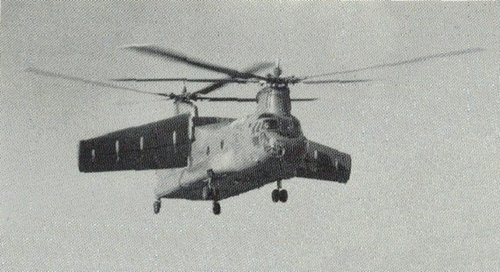
- Joined
- 18 October 2006
- Messages
- 4,202
- Reaction score
- 4,875
Still not completely sure why Airbus Helicopters aren’t in this race, particularly for FLRAA.
I suspect that part of the reason that there are not any foreign rotorcraft is that there are international trade, science and technology, and security issues.
- Joined
- 3 October 2007
- Messages
- 1,960
- Reaction score
- 1,192
Still not completely sure why Airbus Helicopters aren’t in this race, particularly for FLRAA.
I suspect that part of the reason that there are not any foreign rotorcraft is that there are international trade, science and technology, and security issues.
Another, at least for FLRAA is illustrated in HK's post. Given the speed requirements, Airbus would have to bid something using their X3 technology. Among the FLRAA requirements is to be able from either side to rapidly enter/exit on the ground and fastrope from a hover Given the location of the props in most of the illustrations we've seen, including HK's, they couldn't do the former until both props had stopped. Regarding fastrope, you couldn't do that from both sides because of the necessity to have at least one of the props operating anytime you're not firmly on the ground. The props are what provide anti torque.
Possibly Airbus felt there would be too much development and testing for a prop location that avoided these problems to make a bid for FLRAA competitive.
The Airbus solution allows loading from the side and fast rope. You just have to pick which 180 degree quadrant is off limits. With pusher props and a biplane wing like in the newer RACER it’s the rear quadrant that’s dangerous... which is more sensible.Given the speed requirements, Airbus would have to bid something using their X3 technology. Among the FLRAA requirements is to be able from either side to rapidly enter/exit on the ground and fastrope from a hover Given the location of the props in most of the illustrations we've seen, including HK's, they couldn't do the former until both props had stopped.
With the original design it was the front quadrant that was dangerous, but you could still load and fast rope from the rear/side doors. Illustrations from the PDF I attached earlier
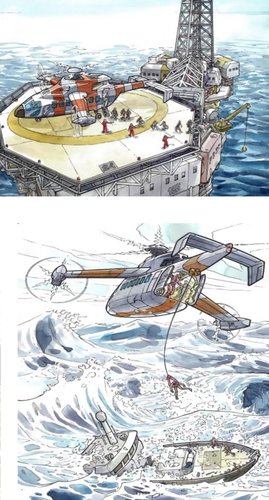
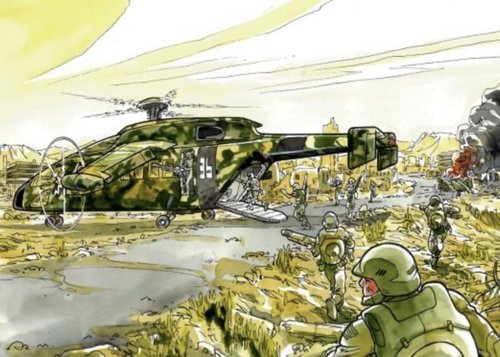
(Per the PDF, this was to be an 11-13 ton, 19 pax, 220 knot helicopter with 70% commonality between the compound and traditional helo variants).
- Joined
- 3 October 2007
- Messages
- 1,960
- Reaction score
- 1,192
The Airbus solution allows loading from the side and fast rope. You just have to pick which 180 degree quadrant is off limits. With pusher props and a biplane wing like in the newer RACER it’s the rear quadrant that’s dangerous... which is more sensible.Given the speed requirements, Airbus would have to bid something using their X3 technology. Among the FLRAA requirements is to be able from either side to rapidly enter/exit on the ground and fastrope from a hover Given the location of the props in most of the illustrations we've seen, including HK's, they couldn't do the former until both props had stopped.
(Per the PDF, this was to be an 11-13 ton, 19 pax, 220 knot helicopter with 70% commonality between the compound and traditional helo variants).
But remember, one of the FLRAA requirements was to be able to rapidly board/exit and fastrope from either side all the time, sometimes simultaneously. You may not have the luxury to give up half your doors for ingress/egress. That was one of the reasons Bell went to non-tilting nacelles in the V-280. Note how in the illustration of the civil version on the oil rig they have people guiding them away from the props. Similarly, in the rescue scenario they're showing one person being lifted. rather than a group, and only from the rear. For civil uses, X3 will work just fine and should very well be considered as a future design option. But here we're talking about a specific military application. Also, in the picture of the military transport (rear ramp use) note how restricted the field of fire is for the side guns. This was another reason Bell didn't use tilting engine nacelles in their final design.
- Joined
- 24 November 2008
- Messages
- 1,547
- Reaction score
- 2,597
Another big issue I see is the ground clearance of the propellers.
Having said that, I still think X³ tech would work for FARA. Attached is a FANTASY/FAKE Airbus X³ FARA proposal I made for the fun of it
We do have a dedicated thread for Airbus Racer related discussions btw: https://www.secretprojects.co.uk/threads/airbus-racer-clean-sky2-lifercraft-demonstrator.28737/
Having said that, I still think X³ tech would work for FARA. Attached is a FANTASY/FAKE Airbus X³ FARA proposal I made for the fun of it
We do have a dedicated thread for Airbus Racer related discussions btw: https://www.secretprojects.co.uk/threads/airbus-racer-clean-sky2-lifercraft-demonstrator.28737/
Attachments
Last edited:



